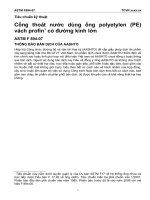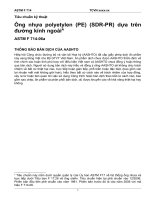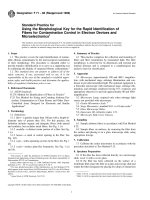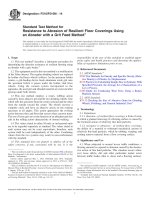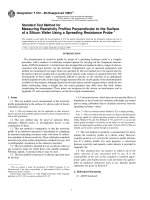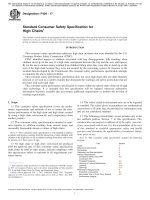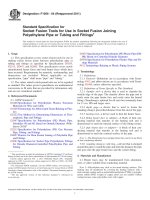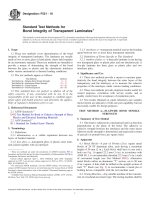Astm f 1359 f 1359m 16a
Bạn đang xem bản rút gọn của tài liệu. Xem và tải ngay bản đầy đủ của tài liệu tại đây (992.02 KB, 13 trang )
Designation: F1359/F1359M − 16a
Standard Test Method for
Liquid Penetration Resistance of Protective Clothing or
Protective Ensembles Under a Shower Spray While on a
Manikin1
This standard is issued under the fixed designation F1359/F1359M; the number immediately following the designation indicates the year
of original adoption or, in the case of revision, the year of last revision. A number in parentheses indicates the year of last reapproval.
A superscript epsilon (´) indicates an editorial change since the last revision or reapproval.
INTRODUCTION
Personnel in industry and emergency response can be exposed to numerous liquids capable of
causing harm upon contact with the human body. These liquids may include chemicals, contaminated
blood or body fluids, and other hazardous liquids. The deleterious effects of different chemicals can
range from acute trauma such as skin irritation and burn, to chronic degenerative disease such as
cancer. Biological-based hazard liquids may include various liquidborne pathogens capable of causing
infection directly or with non-intact skin. Since engineering controls cannot eliminate all possible
exposures, attention is often placed on reducing the potential for direct skin contact through the use
of protective clothing.
Protective clothing is available in a variety of constructions, configurations, and materials, and is
designed to provide various levels of protection against many hazards. Protective clothing offering the
highest level of chemical protection is constructed to prevent any contact of solid, liquid, or gaseous
chemicals with the wearer. Test Method F1052 evaluates the integrity and construction of the vapor
protective ensembles by way of an internal pressure test. In some applications, protective clothing
need only isolate the wearer from splashes of liquids. This test method evaluates the integrity of the
construction and configuration of liquid-penetration-resistant protective clothing or protective
ensembles with a shower spray test.
Resistance of materials used in protective clothing to chemical permeation should be evaluated by
Test Method F739 for continuous contact and Test Method F1383 for intermittent contact (that is,
splash), or by Test Method F1407 using the permeation cup method. Resistance of protective clothing
materials to liquid penetration should be determined by Test Method F903. Resistance of protective
clothing materials specifically to blood and other potentially infectious materials should be determined
by Test Method F1670 and Test Method F1671.
1. Scope
intended that this test method be used to assess the liquid
penetration resistance of protective clothing and protective
ensembles as received from the manufacturer and worn in
accordance with their instructions.
1.1 This test method measures the ability of protective
clothing or protective ensembles to resist liquid penetration in
the form of a shower spray with surfactant-treated water.
1.3 Resistance of materials used in protective clothing to
permeation or penetration can be determined in accordance
with Test Method F739 (or Test Method F1383 or Test Method
F1407) and Test Method F903, respectively. Alternatively,
resistance of materials used in protective clothing to penetration by synthetic blood or liquids containing virus can be
determined in accordance with Test Method F1670 and Test
Method F1671.
1.2 This test method measures the liquid penetration resistance of the construction and configuration of the overall
protective clothing or protective ensemble, but especially of
seams, closures, and interfaces with other components such as
gloves, boots, hoods, and respiratory protective equipment. It is
1
This test method is under the jurisdiction of ASTM Committee F23 on Personal
Protective Clothing and Equipment and is the direct responsibility of Subcommittee
F23.30 on Chemicals.
Current edition approved July 1, 2016. Published October 2016. Originally
approved in 1991. Last previous edition approved in 2016 as F1359/F1359M - 16.
DOI: 10.1520/F1359_F1359M-16A.
1.4 The integrity of vapor protective ensembles is measured
by its ability to maintain positive internal pressure with Test
Method F1052.
Copyright © ASTM International, 100 Barr Harbor Drive, PO Box C700, West Conshohocken, PA 19428-2959. United States
1
F1359/F1359M − 16a
3.1.3.1 Discussion—Voids include gaps, pores, holes, and
imperfections in closures, seams, interfaces and protective
clothing materials. Penetration does not require a change of
state; solid chemicals move through voids in materials as
solids, liquids as liquids and gases as gases. Penetration is a
distinctly different mechanism from permeation.
3.1.4 permeation, n—for chemical protective clothing, the
movements of chemicals as molecules through protective
clothing materials by the processes of (1) absorption of the
chemical into the contact surface of the materials, (2) diffusion
of the absorbed molecules throughout the material, and (3)
desorption of the chemical from the opposite surface of the
material.
3.1.4.1 Discussion—Permeation is a distinctly different
mechanism from penetration.
3.1.5 protective clothing, n—an item of clothing that is
specifically designed and constructed for the intended purpose
of isolating all or part of the body from a potential hazard; or,
isolating the external environment from contamination by the
wearer of the clothing.
3.1.6 protective ensemble, n—the combination of protective
clothing with respiratory protective equipment, hoods, helmets,
gloves, boots, communication systems, cooling devices, and
other accessories intended to protect the wearer from a
potential hazard when worn together.
3.1.6.1 Discussion—For evaluating liquid penetration
resistance, the protective ensemble includes only those clothing items or accessories that are necessary to provide resistance
to liquid penetration.
1.5 The values in SI units or in other units shall be regarded
separately as standard. The values stated in each system must
be used independently of the other, without combining values
in any way.
1.6 This standard does not purport to address all of the
safety concerns, if any, associated with its use. It is the
responsibility of the user of this standard to establish appropriate safety and health practices and determine the applicability of regulatory limitations prior to use.
2. Referenced Documents
2.1 ASTM Standards:2
D1331 Test Methods for Surface and Interfacial Tension of
Solutions of Paints, Solvents, Solutions of Surface-Active
Agents, and Related Materials
F739 Test Method for Permeation of Liquids and Gases
through Protective Clothing Materials under Conditions of
Continuous Contact
F903 Test Method for Resistance of Materials Used in
Protective Clothing to Penetration by Liquids
F1052 Test Method for Pressure Testing Vapor Protective
Suits
F1383 Test Method for Permeation of Liquids and Gases
through Protective Clothing Materials under Conditions of
Intermittent Contact
F1407 Test Method for Resistance of Chemical Protective
Clothing Materials to Liquid Permeation—Permeation
Cup Method
F1670 Test Method for Resistance of Materials Used in
Protective Clothing to Penetration by Synthetic Blood
F1671 Test Method for Resistance of Materials Used in
Protective Clothing to Penetration by Blood-Borne Pathogens Using Phi-X174 Bacteriophage Penetration as a Test
System
4. Summary of Test Method
4.1 A properly fitting test specimen (protective clothing or
protective ensemble) is placed on a standardized manikin that
is already dressed in a specified liquid-absorptive garment
covering portions of the manikin form that are of interest.
2.2 AATCC Standards3
AATCC Test Method 135 Dimensional Changes in Automatic Home Laundering of Woven and Knitted Fabrics
4.2 Water, treated to achieve a surface tension of
0.032 6 0.002 N/m [32 6 2 dynes ⁄cm] is sprayed at the test
specimen from nozzles positioned in a specific configuration
with respect to the specimen. The specimen is exposed to the
liquid spray for a specified period in each of four specimen
orientations.
4.2.1 In Procedure A, five nozzles are positioned in the same
plane and directed towards the center of the manikin from
specified locations above and to the sides of the manikin. The
manikin is rotated 45° through each of four different orientations.
4.2.2 In Procedure B, three nozzles are positioned in a
vertical line parallel to the vertical plane of the manikin and are
located and directed towards certain targets on the manikin.
The manikin is rotated 90° through each of four different
orientations.
3. Terminology
3.1 Definitions:
3.1.1 liquid splash protective clothing, n—protective clothing used to protect the wearer from liquid splashes and other
forms of incidental liquid contact.
3.1.2 liquid splash protective ensemble, n—protective ensemble used to protect the wearer from liquid splashes and
other forms of incidental liquid contact.
3.1.3 penetration, n—for chemical protective clothing, the
movement of substances through voids in protective clothing
materials or items on a nonmolecular level.
4.3 Liquid penetration resistance is determined by the absence of observable wetting of the inner liquid-absorptive
garment, or by the absence of observable liquid detected on the
interior of the specimen, or both.
2
For referenced ASTM standards, visit the ASTM website, www.astm.org, or
contact ASTM Customer Service at For Annual Book of ASTM
Standards volume information, refer to the standard’s Document Summary page on
the ASTM website.
3
Available from American Association of Textile Chemists and Colorists
(AATCC), P.O. Box 12215, Research Triangle Park, NC 27709-2215, http://
www.aatcc.org.
4.4 The test specimen is rated as passing if liquid does not
penetrate and as failing if liquid does penetrate.
2
F1359/F1359M − 16a
TABLE 1 Manikin Dimensions
5. Significance and Use
Dimension
A – Height (from floor)
B – Chest circumference
C – Shoulder circumference
D – Waist circumference
E – Calf circumference
F – Shoulder pivot to floor
G – Crotch height
H – Knee pivot to floor
I – Arm span
5.1 This test method evaluates the ability of the construction
and configuration of protective clothing or protective ensembles to resist liquid penetration. In most cases, the conditions used in this test method will not represent actual end-use
conditions.
5.2 Two different spray configurations are used for exposing
the protective clothing or protective ensemble on a manikin.
5.2.1 Procedure A involves five shower nozzles with one
nozzle directly above the clothed manikin and two nozzles
each to upper and lower sides of the manikin that are all
positioned in the same vertical plane. This spray configuration
is intended to provide a full exposure of the entire protective
clothing or protective ensemble system.
5.2.2 Procedure B involves three shower nozzles that are
positioned at different heights on a vertical line that is parallel
to the manikin with the locations and direction of each nozzle
set with respect to targets on the manikin. This spray configuration is intended to provide a direct assessment of garment
features such as the front closure.
Measurement (mm)A
1828
965
1357
800
385
1420
865
480
2194
A
All dimensions ±12 mm as shown in Fig. 1 corresponding to given letter; shoulder
circumference (C) and pivot to floor height (F) determined at joint of manikin; arm
span (I) determined with arms spread out horizontal at joint from sides of body.
as possible between the clothing or ensemble and the inner
liquid-absorptive garment.
5.9 Results on a mismatched size of clothing or ensemble
shall not be used to generalize about a particular construction
or configuration. Manikin fit potentially affects liquid penetration resistance determinations.
5.10 There are no known restrictions to the types of protective clothing or protective ensembles that can be evaluated with
this test method.
5.3 The selected duration of the test is not intended to
simulate user exposure to splashes of liquid substances but
rather to provide sufficient time for enough liquid to penetrate
to make visual detection easier. The default liquid exposure
time for Procedure A is 20 min. The default liquid exposure
time for Procedure B is 10 min.
5.3.1 It is permissible to specify shorter test durations. It is
recommended that the duration of exposure be the same in each
manikin orientation.
5.3.2 The choice of different test duration is partly based on
the number of layers in the specimen being tested, some of
which serve to absorb the surfactant-treated test liquid and
result in attenuating the severity of the liquid challenge to the
specimen.
5.11 In some cases protective clothing or protective ensembles that show no liquid penetration during this test method
will still fail to protect wearers against specific liquids due to
the material degradation, penetration, or permeation or the
effects associated with the vapors of liquid chemicals.
5.12 In some cases protective clothing or protective ensembles that show no liquid penetration during this test method
will fail to protect wearers in specific circumstances as, for
example, deluge or immersion.
6. Apparatus
6.1 Human-Form Manikin,4 Use a human-form manikin for
testing the protective clothing or protective ensemble. The
preferred manikin is sized to meet the dimensions provided in
Table 1 and as described in Fig. 1. This preferred manikin also
has articulation at the shoulders, elbows, hips, and knees as
shown in the example manikin presented in Fig. 2. Characteristics of the preferred manikin include a removable, nonrotating head, removable pliable hands, and removable feet
with a water-resistant coating that is shown to limit surfactant
treated liquid absorption in the manikin skin.
6.1.1 The use of an alternative manikin is permitted. If an
alternative manikin is used, report the use of a different
manikin in terms of manikin dimensions provided in Table 1.
6.1.2 Unless otherwise specified, the manikin is positioned
so that the manikin body is in a full vertical orientation with the
manikin head looking forward, manikin legs straight, and
manikin arms pointing downward by the sides of the manikin
torso.
5.4 A nontoxic, non-foaming surfactant is added to water
for this test method to simulate liquids of lower surface
tensions. Liquids of specific interest can be simulated by
treating water to achieve an equivalent surface tension.
5.5 For protective clothing with water-repellent surfaces,
the lower surface tension liquid will aid in the evaluation of the
construction and configuration of the garment because it is less
likely to be repelled and more likely to wet the protective
clothing. This is especially useful for reusable garments whose
water-repellent surface interferes with the evaluation of their
construction and configuration when new, but is diminished
after wearing and washing.
5.6 Fluorescent or colored dyes are permitted to be added to
the water to enhance detection of liquid penetration into the
protective clothing or protective ensemble.
5.7 This test method can be used by both manufacturers and
end users to assess liquid penetration resistance. Manufacturers
can use this test method to evaluate quality of construction and
effectiveness of clothing and ensemble configurations.
4
The sole source of supply of the apparatus known to the committee at this time
is Rubens Display World, 1482 E. Francis Street, Ontario, CA, 91761. If you are
aware of alternative suppliers, please provide this information to ASTM International Headquarters. Your comments will receive careful consideration at a meeting
of the responsible technical committee,1 which you may attend.
5.8 The clothing or ensemble is sized to fit the manikin. It is
important that the clothing be selected to fit the manikin well
since detection of liquid penetration requires as much contact
3
F1359/F1359M − 16a
FIG. 1 Manikin Measurement Locations
Drying Procedure Ai. Determine the suitability of the garment
material by dispensing a 1 mL droplet of the surfactant-treated
water specified in 9.1.1 on the fabric laying completely flat
over a non-absorbent surface (such as a piece of wax paper)
and measuring the largest diameter of the liquid mark. The
fabric is suitable when the liquid mark has a diameter of at least
45 mm after 60 s following the application of the droplet on the
fabric surface.
6.2.1 If testing a full ensemble, use a hood covering the
appropriate areas of the head constructed of a fabric that shows
the same liquid marking characteristics in 6.2 where a 1 mL
droplet of surfactant-treated water prepared as described in
9.1.1 and dispensed on the fabric sample laying completely flat
creates a liquid mark diameter that is greater than 45 mm after
60 s. If the ensemble hood interfaces with a respirator, use a
hood that does not interfere with the placement of a facepiece.
6.2.2 If evaluating leakage into the gloves or glove to
clothing interfaces, provide gloves constructed of a fabric that
shows the same liquid marking characteristics in 6.2 where a
1 mL droplet of surfactant-treated water prepared as described
in 9.1.1 and dispensed on the fabric sample laying completely
flat creates a liquid mark diameter that is greater than 45 mm
after 60 s.
6.2.3 If evaluating leakage into the footwear or footwear to
clothing interfaces, provide socks constructed of a fabric that
shows the same liquid marking characteristics in 6.2 where a
1 mL droplet of surfactant-treated water prepared as described
in 9.1.1 and dispensed on the fabric sample laying completely
flat creates a liquid mark diameter that is greater than 45 mm
after 60 s.
FIG. 2 Example of Articulate Manikin
6.2 Liquid-Absorptive Inner Garment, Use one or more
inner garments to cover all areas of the manikin that are of
interest as an aid to observe liquid penetration. Choose
torso-based inner garments that are constructed of medium
gray, 270 to 550 g/m2 [8 to 16 oz/yd2], 100 % cotton, 95 %
cotton/5 % polyester, or 90 % cotton/10 % polyester sweatshirt
fleece fabric, which is finish free and that is easily watermarked. Orient the material so that the knit side is on the
exterior while the fleece side is the interior surface. Launder
the inner garment a minimum of ten times using AATCC Test
Method 135, Machine Cycle 1, Wash Temperature V, and
6.3 Standard Shower System (Procedure A)—The standard
shower system consists of five low-flow shower head nozzles
and a pressurized liquid supply. The five nozzles are oriented
with respect to the manikin as specified in Fig. 3.A laser
4
F1359/F1359M − 16a
FIG. 3 Positions of Shower Nozzles with Respect to Manikin for Procedure A
pointing device shall be used for positioning each nozzle with
respect to the manikin. The nozzles conform to the specifications given in Fig. 4.5 The pressurized liquid is delivered at
3.0 6 0.2 L/min [48 6 3 gal ⁄h] through each nozzle and
includes a means for monitoring the liquid flow through each
nozzle during the test.
6.4 Alternative Shower System (Procedure B)—The alternative shower system consists of three low-flow shower head
nozzles conforming to the specifications in Fig. 4,5 and a
pressurized liquid supply. The three nozzles are oriented with
respect to the manikin as specified in Fig. 5 with detailed
specifications provided in Annex A1 showing the specific
targets on the manikin, distance from the nozzles, and method
for properly aligning the manikin. Various means can be used
for supporting the nozzles in a manner that ensures their
positions are maintained over the duration of the testing. A
laser pointing device shall be used for positioning the manikin.
The pressurized liquid supply is delivered at 3.0 6 0.2 L ⁄min
[48 6 3 gal ⁄h] through each nozzle and includes a means for
monitoring the liquid flow through each nozzle during the test.
6.5 Manikin Positioning Platform, a platform on which the
feet of the manikin are secured to permit positioning of the
manikin and nozzles with respect to the liquid spray. Choose a
platform that has a means to allow its rotation to each of the
required orientations while maintaining the manikin securely.
NOTE 1—Whether evaluated or not, use footwear on the manikin feet to
5
Type #SS1B and SS1C nozzles meet this requirement. The sole source of
supply of the nozzles known to the committee at this time is Whedon Products,
Inc., 212 Andover Dr., West Hartford, CT 06107. If you are aware of alternative
suppliers, please provide this information to ASTM International Headquarters.
Your comments will receive careful consideration at a meeting of the responsible
technical committee,1 which you may attend.
NOTE 1—All dimensions are in inches (1 in. = 25.4 mm). All
dimensions are approximate to the nearest 0.01 inch.
FIG. 4 Shower Nozzle Specifications
5
F1359/F1359M − 16a
FIG. 5 Overview of Procedure B Shower System Configuration
7.3 After testing, and before returning the specimen to
service or storage if it is to be used, ensure the following:
7.3.1 The specimen is dry, and
7.3.2 The specimen has been cleaned to remove all surfactant residue, and is correctly assembled for reuse.
8.2.1 For sealing the top of a non-hooded garment, place a
suitably sized 1 mm or thicker plastic bag over the manikin
head that extends over the top of the collar and seal with
waterproof tape. Ensure that the tape is at least 25 mm above
the portion of the collar for the protective clothing item that is
being evaluated.
8.2.2 For sealing off the sleeves of garments where no
gloves are attached, a tapered open can or cylinder that fits
inside the sleeve and is then taped to the sleeve is one means
of isolating the sleeve end. An alternative means is to place a
suitably sized 1 mm or thicker plastic bag over the sleeve end
and seal with waterproof tape.
8.2.3 For sealing off the face/respirator opening of a hooded
garment, place a semi-rigid plastic cut out that is larger than the
face opening when the garment is donned onto the manikin.
Alternatively block off the entire hood region in accordance
with 8.2.1 ensuring that the sealed off area is above the hood to
garment seam and seal with waterproof tape.
8. Specimen Preparation
9. Procedure
8.1 Protective clothing or protective ensemble components
shall be tested as received unless otherwise specified. Select
the size of the protective clothing or protective ensemble
components to be tested as correct for the size of the manikin
for the dimensions provided in Table 1. If the manufacturer’s
instructions specify wearer weight as one of the parameters
used in selecting the correct size of the garment, assume that
the manikin has an equivalent human weight of 72.5 kg
[160 lbs]. These instructions shall account for putting the
protective clothing or protective ensemble onto specified
manikin. Duct tape and other nonuniform methods for closing
or sealing interfaces shall not be used.
9.1 Prior to each series of tests:
9.1.1 Add a sufficient amount of a nontoxic, non-foaming
surfactant to the water supply to achieve a surface tension of
0.032 6 0.002 N/m [32 6 2 dynes ⁄cm].6 Periodically evaluate
the surface tension of the challenge liquid using Test Method
D1331. It is permissible to recirculate the liquid as long as the
surface tension of the liquid is maintained over the test or series
of testing being performed.
allow the manikin to stand vertically. The use of snowboard footwear
bindings or similar device is recommended for securing the manikin to the
platform.
6.6 Stopwatch, or other appropriate timing device.
6.7 Laser Pointing Device, or similar device, to aid in
positioning shower nozzles with respect to manikin.
7. Precautions
7.1 Conduct the test method in an area designed to collect
liquid runoff.
7.2 Keep unprotected observers from being exposed to the
test liquid.
6
A 0.1 weight % solution of Surfynol 104H with water gives a surface tension
of approximately 33.8 dynes/cm. The sole source of supply of the apparatus known
to the committee at this time is Air Products and Chemical, Inc., Performance
Chemicals, Box 538, Allentown, PA 18105. If you are aware of alternative
suppliers, please provide this information to ASTM International Headquarters.
Your comments will receive careful consideration at a meeting of the responsible
technical committee,1 which you may attend.
8.2 Parts of the protective clothing or protective ensemble
that are not to be tested shall be suitably blocked off with
waterproof tape or other means to prevent liquid from penetrating those areas.
6
F1359/F1359M − 16a
FIG. 6 Orientation of Suited Manikin Exposures for Procedure A
liquid spray for 2.5 min, + 5 s, – 0 s, in the following sequence:
0°, 90°, 180°, and 270°, in accordance with the orientations
shown in Fig. 7. Do not interrupt the liquid spray in transitioning from one orientation to another.
9.6 At the end of the liquid spray period following either
Procedure A or Procedure B, remove excess liquid from the
surface of the test garment. Absorbent toweling is one method
that works well. Do not apply excessive pressure in wiping off
the test garment exterior.
9.1.2 Check that the flow from each nozzle is uniform and
the nozzle orifices are free from deposits or other effects that
would affect the spray pattern; periodically clean the nozzles.
9.1.3 Calibrate the liquid flow rate through each nozzle at
least one minute following the initial of flow by collecting the
total volume output through the respective nozzle over a 1 to 2
min period.
9.1.4 Inspect the liquid-absorptive inner garment and protective clothing or protective ensemble (and other ensemble
components and equipment to be tested) for total dryness
before using.
NOTE 2—The purpose of exterior drying is to prevent the transfer of
exterior liquid to the interior of the test ensemble or garment, or to the
inner liquid-absorbent garments. Since the characteristics of exterior
materials will have different propensities for absorbing challenge liquid,
drying procedures can be adapted depending on the amount of residual
liquid on the specimen exterior, if liquid has pooled in any one area, and
the type of garment being evaluated.
9.2 Put the liquid-absorptive inner garment(s) on the manikin. Use an inner garment or a combination of inner garments,
which cover all areas of the manikin that are of interest. Use
inner liquid-absorptive hoods, gloves, and socks, as applicable.
9.3 Put the protective clothing or protective ensemble to be
tested over the inner garment on the manikin in accordance
with the manufacturer’s instructions, accounting for any specialized instructions for placing the protective clothing or
protective ensemble onto the manikin. Place and attach additional ensemble components and equipment, such as
respirators, gloves, or footwear, on the manikin in accordance
with the manufacturer’s directions.
9.3.1 Unless otherwise specified, position the manikin with
its head looking forward, arms pointing downward by the sides
of the vertically oriented torso, and legs straight. Tighten the
manikin joints to ensure that the manikin maintains this
position during testing.
9.7 Remove the test protective clothing or protective ensemble in a dry area and any other ensemble components or
equipment from the manikin. Complete both the drying of the
test garment or ensemble and their removal from the manikin
within 10 min following the conclusion of the liquid spray
period.
9.8 Inspect the protective clothing or protective ensemble
following the liquid spray period for evidence of liquid
penetration. Determine liquid penetration by one of the following procedures:
9.8.1 Examine the inner garment, garment liners, and garment interior for signs of wetness. Record these areas as
locations of wetness.
9.8.2 If a dye is added to the liquid, remove the protective
clothing or protective ensemble and any other ensemble
components or equipment from the manikin, and examine the
inner garment, garment liners, and garment interior for the
appearance of any dye-colored areas. Record these areas as
locations of wetness.
9.8.3 If a fluorescent dye is added to the liquid, examine the
inner garment, garment liners, and garment interior under
ultraviolet lighting in a dark room for fluorescing areas. Record
these areas as locations of wetness.
9.9 Record any protective clothing or protective ensemble
as passing if no areas of wetness are observed or otherwise
detected. If there are areas of wetness, record the protective
clothing or protective ensemble as failing.
9.4 Block off from exposure to the liquid spray any areas of
the manikin or protective clothing or protective ensemble not
being evaluated as specified in Section 8.
9.5 Spray liquid at the rate of 3.0 6 0.2 L ⁄min
[48 6 3 gal ⁄h] through each nozzle simultaneously.
9.5.1 When using Procedure A, expose the suited manikin to
the liquid spray for a period of 20 min, 5 min in each of four
orientations show in Fig. 6. Do not interrupt liquid spray when
transitioning from one orientation to the next.
9.5.1.1 Alternatively expose the suited manikin for a different period of time divided into four equal periods for exposing
the manikin in each of the four orientations.
9.5.2 When using Procedure B, expose the suited manikin
for a total of 10 min with the suited manikin exposed to the
7
F1359/F1359M − 16a
FIG. 7 Orientation of Suited Manikin Exposures for Procedure B
10.2.4 Position of Manikin—Indicate the position of the
manikin if different than as specified in 9.3.1.
10.2.5 Duration of Liquid Exposure—Identify the length of
the liquid exposure period if different than that specified to the
specific procedure and include the exposure time in each
manikin orientation.
10.2.6 Description of the Area Tested—List any area of the
protective clothing or protective ensemble blocked off from
exposure to the liquid spray and the reason that the particular
area was not tested.
10.2.7 Liquid Test Agent Used—Identify the type of
surfactant, brand name, identification number, concentration,
and surface tension of the liquid test agent. Indicate if any dyes,
fluorescent agents, or other detection aids were used in the
liquid test agent.
10.2.8 Determination Technique—Describe the procedure
for determining liquid penetration.
10.2.9 Test Result—Report the test result as pass or fail.
10.2.10 Description of Leakage Areas—Report the specific
areas of leakage observed for the protective clothing or
protective ensemble, if found to fail, by identifying both the
specific locations and relative amount of leakage observed.
Note if the failure was observed on the garment interior or on
the liquid-absorptive garment and probable reasons for each
failure. Include any photographs or diagrams showing the
leakage as part of the report.
9.9.1 Distinguish whether wetness occurs on the interior of
the protective clothing or on the liquid-absorptive garment, and
the specific areas and relative amounts of wetness in estimated
surface area of the protective clothing or liquid-absorptive
garment showing wetness.
9.9.2 Identify the location and describe the specific areas of
leakage observed for the protective clothing or protective
ensemble, if leakage is noted. As part of the description,
indicate the relative amount of leakage that is noted in terms of
observed wetted area on the inner absorptive garment or the
interior of the garment, as applicable.
NOTE 3—Photographs or diagrams are suggested as a means for
documenting the areas of protective clothing or protective ensemble
leakage.
9.9.3 Describe the probable reason for each failure, if
possible.
10. Report
10.1 State that the protective clothing or protective ensemble was tested in accordance with Test Method F1359/
F1359M.
10.2 Report the following information:
10.2.1 Description of the Protective Clothing or Protective
Ensemble—Include unique identification number, identifying
brand name, manufacturer, date of purchase, date of manufacture if available, size, materials of construction, and unique
clothing features, for example, special fittings to accommodate
respiratory equipment.
10.2.2 Description of Ensemble Components (if
applicable)—Include the type of item, unique identification
number, identifying brand name, date of purchase, date of
manufacture if available, size, materials of construction, and
method of attachment.
10.2.3 Type of Shower System Used—Indicate whether Procedure A or Procedure B was used.
11. Precision and Bias
11.1 An interlaboratory evaluation is in the process of being
conducted.
12. Keywords
12.1 liquid penetration resistance; liquid splash protective
clothing; liquid splash protective ensembles; protective clothing; protective ensemble; shower spray test
8
F1359/F1359M − 16a
ANNEX
(Mandatory Information)
A1. Positioning of Nozzles in Procedure B Shower System
FIG. A1.1 Measurement Down from Manikin Chin
A1.1 Position of Targets on Manikin
FIG. A1.2 Measurement from Chin to Target Location
A1.1.1 Use a standard 6 mm [1⁄4 in.] washer to mark target
areas and affix to manikin with glue.
A1.1.2 To locate the center of the middle target, measure
from bottom of chin down 375 mm [143⁄4 in.]; refer to Fig.
A1.1 and Fig. A1.2.
A1.1.3 To locate the center of the top target, measure from
center of middle target up 311 mm [12 1⁄4 in.] as shown in Fig.
A1.3.
A1.1.4 To locate the center of the bottom target, measure
from center of middle target down 311 mm [121⁄4 in.] as shown
in Fig. A1.4.
A1.2 Setting Distance of Manikin from Middle Nozzle
A1.2.1 Using a laser pointing device that fits into the direct
center of the middle spray nozzle, adjust the height of the
central nozzle such that it is horizontal to the center manikin
target using a tolerance of 6 0.5 mm [1⁄4 in.].
A1.2.2 With the manikin standing vertical, the distance
from the middle target to the tip of the middle nozzle is
560 mm [22 in.] as shown in Fig. A1.5 and Fig. A1.6.
A1.3 Setting Heights and Positions of Spray Nozzles
A1.3.1 Ensure that middle nozzle is parallel with center
target on manikin (see Fig. A1.7 and Fig. A1.8).
FIG. A1.3 Measurement to Position Top Manikin Target
A1.3.2 To locate center of top spray nozzle, measure from
the center of middle spray nozzle up 760 mm [30 in.] as shown
in Fig. A1.9.
A1.3.4 To locate center of bottom spray nozzle, measure
from the center of middle spray nozzle down 686 mm [27 in.]
as shown in Fig. A1.10.
A1.3.3 Use laser pointer in top spray nozzle to align top
spray nozzle angle with center of upper manikin target.
A1.3.5 Use laser pointer in bottom spray nozzle to align
bottom spray nozzle angle with center of lower manikin target.
9
F1359/F1359M − 16a
FIG. A1.4 Measurement to Position Bottom Manikin Target
FIG. A1.5 Measuring Distance from Central Nozzle to Center Manikin Target
10
F1359/F1359M − 16a
FIG. A1.6 Measuring Distance from Central Nozzle to Center Manikin Target—View 2
FIG. A1.7 Ensuring Correct Height of Middle Nozzle with Respect to Center Target on Manikin
11
F1359/F1359M − 16a
FIG. A1.8 Laser Pointed to Center Target on Manikin
FIG. A1.9 Locating Height of Top Spray Nozzle with Respect to Middle Spray Nozzle
12
F1359/F1359M − 16a
FIG. A1.10 Locating Height of Bottom Spray Nozzle with Respect to Middle Spray Nozzle
ASTM International takes no position respecting the validity of any patent rights asserted in connection with any item mentioned
in this standard. Users of this standard are expressly advised that determination of the validity of any such patent rights, and the risk
of infringement of such rights, are entirely their own responsibility.
This standard is subject to revision at any time by the responsible technical committee and must be reviewed every five years and
if not revised, either reapproved or withdrawn. Your comments are invited either for revision of this standard or for additional standards
and should be addressed to ASTM International Headquarters. Your comments will receive careful consideration at a meeting of the
responsible technical committee, which you may attend. If you feel that your comments have not received a fair hearing you should
make your views known to the ASTM Committee on Standards, at the address shown below.
This standard is copyrighted by ASTM International, 100 Barr Harbor Drive, PO Box C700, West Conshohocken, PA 19428-2959,
United States. Individual reprints (single or multiple copies) of this standard may be obtained by contacting ASTM at the above
address or at 610-832-9585 (phone), 610-832-9555 (fax), or (e-mail); or through the ASTM website
(www.astm.org). Permission rights to photocopy the standard may also be secured from the Copyright Clearance Center, 222
Rosewood Drive, Danvers, MA 01923, Tel: (978) 646-2600; />
13
